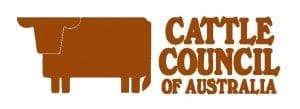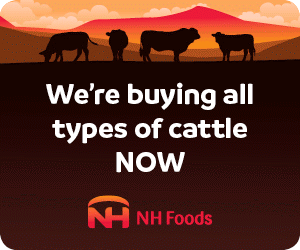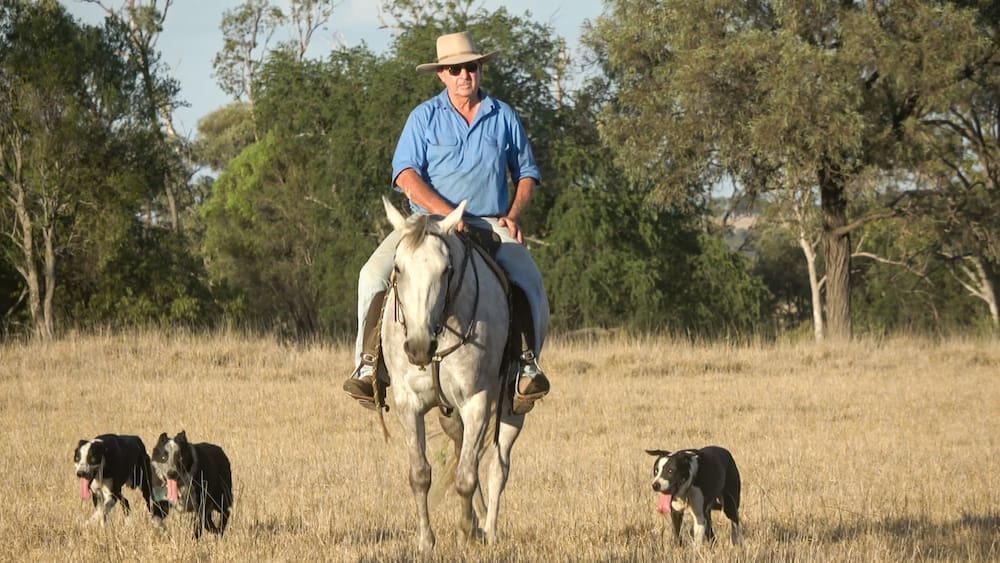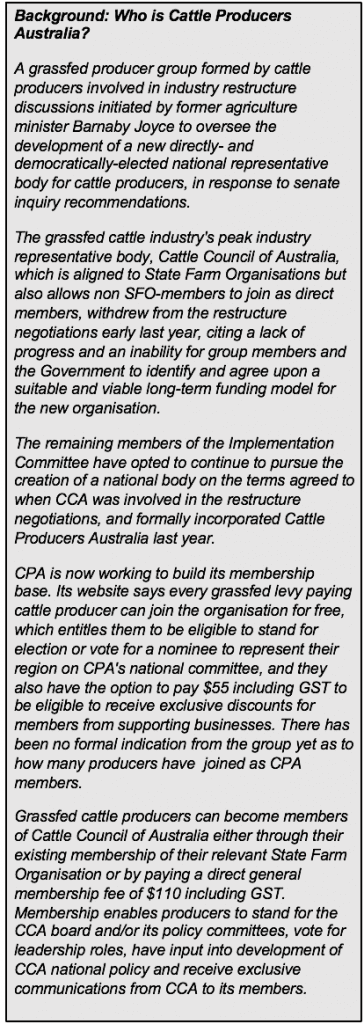The Cattle Producers Australia group says that despite a number of senate inquiries and an ACCC cattle and beef market study recommending whole of supply chain cooperation, particularly between producers and processors, the return to low cattle prices shows no progress has been made towards that goal.
However, Cattle Council of Australia and Australian Meat Industry Council have rejected the claims, pointing out that price fluctuations are supply driven and that there are many and increasing examples of producers and processors working together in dedicated branded supply chains to flatten out price peaks and troughs.
Taroom cattle producer and veterinarian Dr Paul Wright, the inaugural chair of CPA, issued a media statement this week saying the return to low cattle prices now being experienced further demonstrated the need for “robust and accountable cattle producer representation” at the national level.
He said cattle producers are now receiving the lowest prices since 2015, despite Australia shipping high export tonnages of beef at high export prices.
“Reports of near record monthly export tonnage, along with buoyant export beef prices, combined with high domestic wholesale and retail price levels which are threatening to dampen domestic consumer demand, is not compatible with the low prices, hovering around 2015 levels, that cattle producers are receiving for their stock,” he said.
“This is evidence as to how far we have come, which is basically nowhere. We have not progressed whole of supply chain cooperation.”
In the CPA statement Dr Wright said the group rejected comments from the Australian Meat Industry Council that producers and processors were now working together and were more cohesive than ever.
“With record retail beef price heights to $19.51 per kg according to MLA, indicates the market place seems to only respond to livestock supply issues rather than product demand and producers are questioning why the benchmark Eastern Young Cattle Indicator (EYCI) this week slid to 385.25 cents?
“Leaving producers receiving a meagre 26 pc share of the retail price, MLA reported a 10 year average of 32pc back in 2015 and according to USDA reports America is receiving 46.7 pc.”
Effective producer representation was needed to deliver genuine transparency in pricing along the supply chain.
He said he ACCC Cattle and Beef Market study highlighted the lack of transparency, stating that 90 percent of slaughter cattle in Australia were sold direct.
Dr Wright acknowledged some meat processors had begun to publish their price grids in response to Senate Inquiry into the Effect of Market Consolidation and the ACCC Cattle and Beef Market study. However he said this was not enough, with those processors still using their own language and descriptors and variation discount rules which made it “virtually impossible for the average cattle producer to compare prices being offered for their cattle”.
“Price transparency is fundamental to the efficiency of a free market economy and lack of transparency results in lower prices for the price taker and higher profits for the price giver,” he said.
“If processors are buying 90pc of their product direct over the hooks, they will not be competing in the public selling centres where the EYCI is set, yet processors often use the EYCI to benchmark their grid pricing.
“This brings us back to the core problem of representation, price transparency and the other reform recommendations from past senate inquiries and the ACCC study that have not been dealt with and hearing from our younger cattle producing members who have raised these specific issues with me and have little faith in existing industry structures ability to manage them.”
Price movements dictated by supply: Cattle Council
Cattle Council of Australia responded to Dr Wright’s claims by pointing out that price fluctuations are supply driven.
 “It is wrong to suggest that a lower indicator price is anything more than a reflection on a supply chain which is trying to absorb a significant turn-off of cattle due to ongoing drought. It isn’t long ago that we were seeing record cattle prices which were, in large part, caused by a shortage of supply after a drought,” CCA said in a statement to Beef Central.
“It is wrong to suggest that a lower indicator price is anything more than a reflection on a supply chain which is trying to absorb a significant turn-off of cattle due to ongoing drought. It isn’t long ago that we were seeing record cattle prices which were, in large part, caused by a shortage of supply after a drought,” CCA said in a statement to Beef Central.
“Blaming processors for market prices is short-sighted.
 “Our supply chains are integrated in a way that helps avoid the massive boom-bust price cycles of the past.
“Our supply chains are integrated in a way that helps avoid the massive boom-bust price cycles of the past.
“The way processors, lot feeders, backgrounders and live exporters are still providing producers selling options and competition for drought affected cattle is testament to how far we’ve come.
“As the peak national voice for beef producers, Cattle Council knows we have a responsibility to work with processors to develop our markets, uphold the integrity and reputation of Australian beef and strengthen the resilience of the businesses and families who produce it.”
AMIC: No correlation between cattle prices and supply chain cohesiveness
AMIC CEO Patrick Hutchinson said it was difficult to make a correlation between cattle prices and supply chain cohesiveness.
“We certainly don’t believe there is a correlation between what is viewed as industry cohesiveness and pricing of livestock.
“If we looked at 2016, we saw the EYCI at a record 725c/kg with a median price of about 640c/kg.
“In 2017 the median was about 613c/kg and in 2018 the median was about 520c/kg.”
In the past week the EYCI had risen again by almost 50c/kg due to rainfall, a 10-15pc cost increase in seven days.
At the time processors were paying record prices they were also enduring massive hikes in electricity and gas prices, a period that saw a number of processing plants close down.
What was more important he said was for the industry, government and community to recognise the total value chain of the red meat industry, and understanding where costs were causing were reducing the competitiveness of the entire sector.
Australian processors and meat retailers faced the highest costs of any country in the world by a long way, he said.
Energy was a key example. He said AMIC explained to the Federal Energy Minister earlier this week that Australian processors and almost 2000 independent red meat retailers were the largest per square metre energy users and payers in the country.
“What we should as an industry be looking at is where are our major cost points are and what causes the peaks and troughs and how do we work harder at flattening out those things.”
That included greater Federal Government action to address rising energy costs, or State Governments freezing payroll tax to provide some margins and room to breathe.
He said it was important for the Government to look at how it could help farmers by helping the entire supply chain.
“That is the number one key element because, essentially, if our processors can start to flatten out those price indexes, farmers win.”
He said there were already many examples of processors and producers working together in dedicated branded red meat supply chain partnerships.
“If we have processors and producers and others within supply chains operating that way now, why can’t we have a similar process of thinking and appreciation at the industry level?
“I believe we do and I believe we are getting there more and more.”



